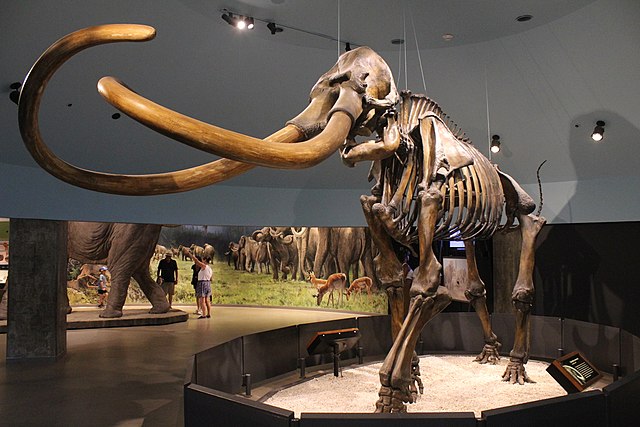Mammuthus primigenius, commonly known as the woolly mammoth, is an iconic and extinct species of mammoth that roamed various parts of the Northern Hemisphere during the Pleistocene epoch. Here’s an exploration of the evolutionary history of Mammuthus primigenius:
1. Taxonomy and Classification:
- Genus: Mammuthus.
- Species: Primigenius.
- Closely Related to Elephants: Mammoths belong to the family Elephantidae, which also includes modern elephants. Mammuthus primigenius is the best-known and most thoroughly studied species among the mammoths.

2. Evolutionary Timeline:
- Pleistocene Epoch: Mammuthus primigenius lived during the Pleistocene epoch, which spanned from approximately 2.6 million to 11,700 years ago.
- Cousin to Other Mammoths: Woolly mammoths were part of a diverse group of mammoths, including species like the Columbian mammoth and the pygmy mammoth.
3. Geographical Distribution:
- Wide Range: Woolly mammoths had a broad geographical distribution, ranging from Europe and Asia to North America.
- Adaptation to Cold Climates: They were well-adapted to cold environments, including the tundra and steppe regions.
4. Physical Characteristics:
- Distinctive Appearance: Woolly mammoths were characterized by their long, curved tusks, a covering of long hair, and a humped back.
- Adaptations to Cold Climate: The thick coat of fur, small ears, and subcutaneous fat helped them survive in cold conditions.
5. Behavior and Social Structure:
- Herbivores: Woolly mammoths were herbivores, feeding on grasses and other vegetation.
- Social Animals: They likely exhibited social behavior, with family groups and herds playing a role in their survival strategy.
6. Interactions with Humans:
- Coexistence: Woolly mammoths coexisted with early human populations.
- Hunting: Humans hunted mammoths for meat, bones, and other resources. Cave paintings and carvings provide evidence of their cultural significance to early humans.
7. Climate Changes and Extinction:
- End of the Pleistocene: The end of the Pleistocene was marked by significant climate changes, including warming temperatures.
- Hypotheses for Extinction: Various factors have been proposed for the extinction of woolly mammoths, including overhunting by humans, environmental changes, and a combination of these factors.
8. Paleogenomics:
- Genetic Studies: Advances in paleogenomics have allowed scientists to study the DNA of woolly mammoths, providing insights into their evolutionary history.
- Cloning Efforts: There have been discussions and efforts to clone woolly mammoths using preserved genetic material.
9. Fossil Discoveries:
- Mummified Remains: Some woolly mammoth specimens have been found remarkably well-preserved in permafrost, including mummified individuals with intact soft tissues.
- Ongoing Discoveries: Ongoing paleontological excavations continue to uncover new information about woolly mammoths and their ancient environments.
The evolutionary history of Mammuthus primigenius is a fascinating chapter in the story of Earth’s Pleistocene megafauna. The study of woolly mammoths provides valuable insights into ancient ecosystems, climate dynamics, and the complex interplay between large mammals and changing environments.











